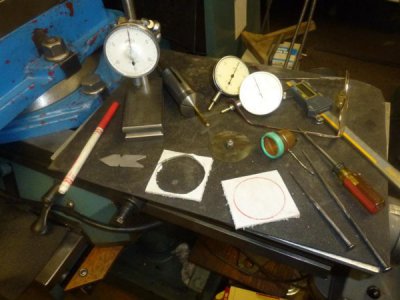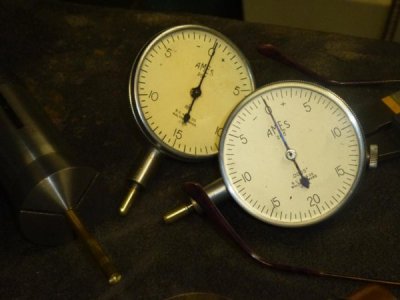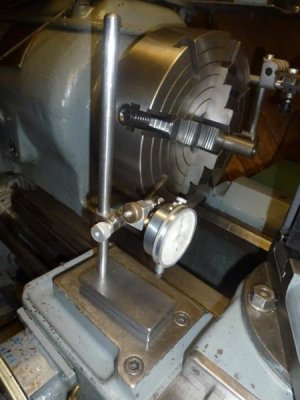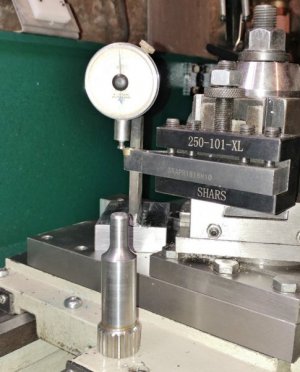- Joined
- Feb 7, 2013
- Messages
- 2,485
The project started while building a comparator stand and looking at several forlorn looking dial indicators with parts
missing. The indicator tips were gone as well as the plastic dial covers were unusable or missing. Apparently the
plastic dial covers have a tendancy to shrink over time so they were with the indicators but would not stay affixed to the
front of the indicator. I did have some nice .125 inch plascic sheet so cut some rounds of the approximate right
size and ground them on the disc sander till they fit the outside plate of the indicator. The only problem was that the
needle would rub on the face of the cover... To make that work, I put some pressure on the center of the lens
and applied some heat with a heat gun to make a convex lens that would clear the needle. That worked well enough
to be acceptable so used some cyanoacrylate to glue the lens to the face of the indicator.
The missing tips is where this project was getting interesting. My material was 3/16 brass rod and the object was
to make some tips with 4-48 thread for the indicators. It was easy to run the lathe with a 48 pitch but to accurately
see the threading required two pair of 3.0 reading glasses! Actually it went pretty well and the tips turned out
just fine.
My comparator stand project which gets worked on occasionally finally had an indicator on it that was usable so
am including a photo of that as well.
Anyway, the project was basically done on the cheap and I didn't have to buy anything as it was all fabricated.
Here's a couple photos of the indicator project as well as the comparator stand in relative completion.



missing. The indicator tips were gone as well as the plastic dial covers were unusable or missing. Apparently the
plastic dial covers have a tendancy to shrink over time so they were with the indicators but would not stay affixed to the
front of the indicator. I did have some nice .125 inch plascic sheet so cut some rounds of the approximate right
size and ground them on the disc sander till they fit the outside plate of the indicator. The only problem was that the
needle would rub on the face of the cover... To make that work, I put some pressure on the center of the lens
and applied some heat with a heat gun to make a convex lens that would clear the needle. That worked well enough
to be acceptable so used some cyanoacrylate to glue the lens to the face of the indicator.
The missing tips is where this project was getting interesting. My material was 3/16 brass rod and the object was
to make some tips with 4-48 thread for the indicators. It was easy to run the lathe with a 48 pitch but to accurately
see the threading required two pair of 3.0 reading glasses! Actually it went pretty well and the tips turned out
just fine.
My comparator stand project which gets worked on occasionally finally had an indicator on it that was usable so
am including a photo of that as well.
Anyway, the project was basically done on the cheap and I didn't have to buy anything as it was all fabricated.
Here's a couple photos of the indicator project as well as the comparator stand in relative completion.





